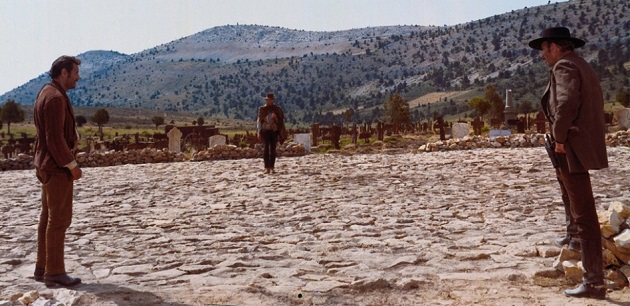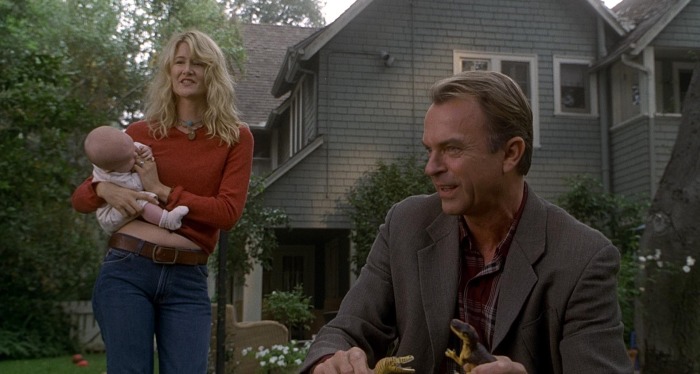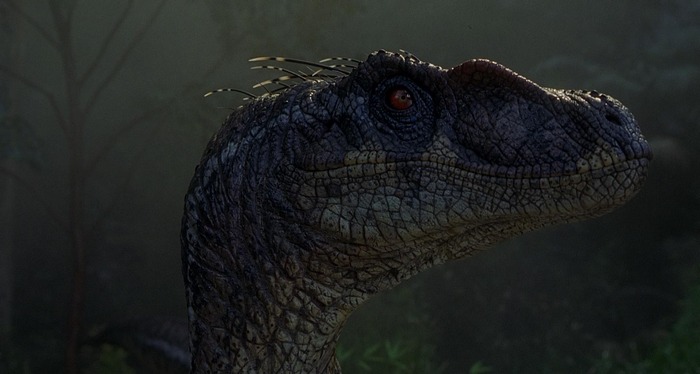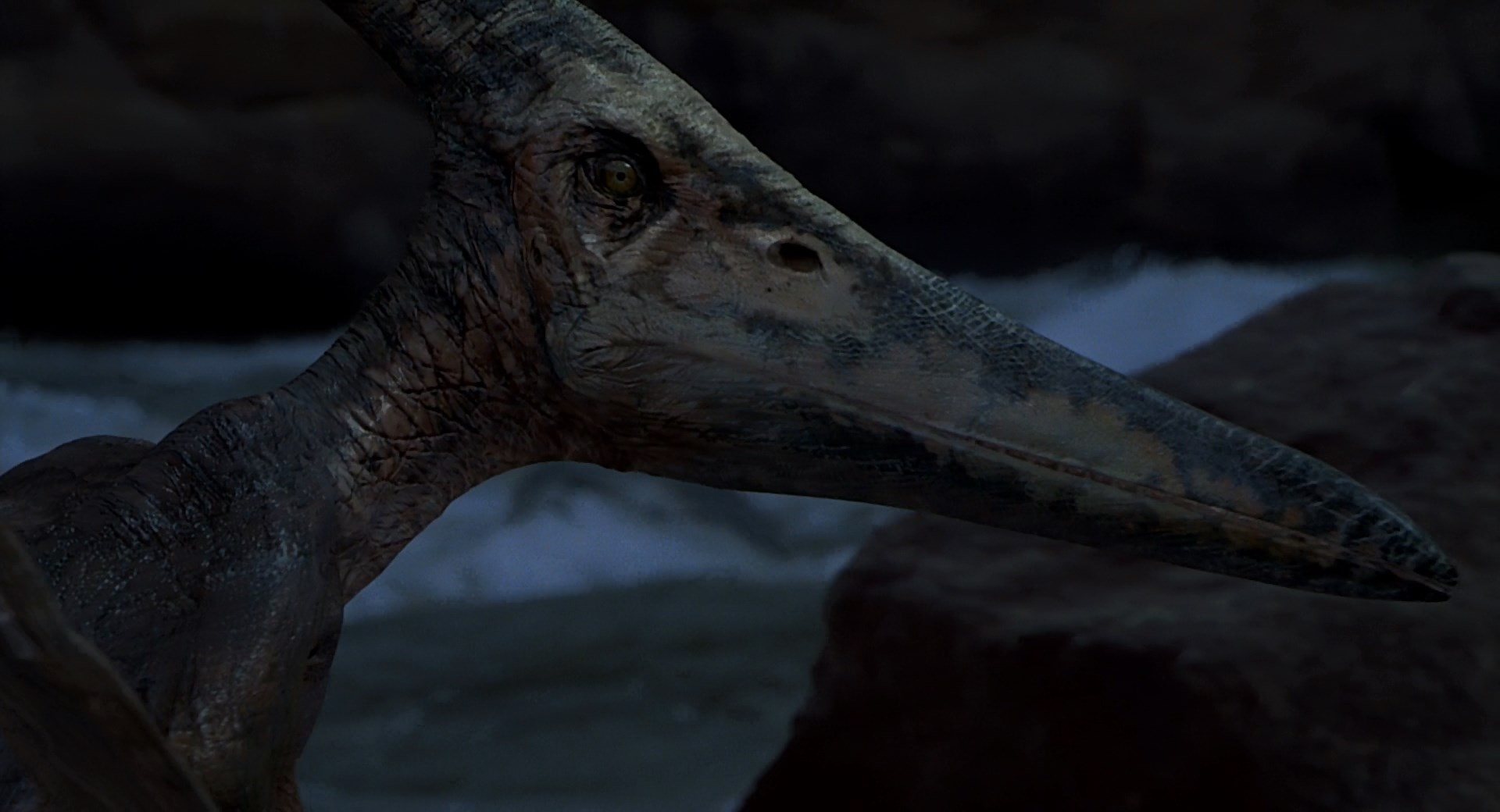The first time I ever heard about the movie was during a trip to Disney World on "The Great Movie Ride" at Disney's "Hollywood Studios" where I was exposed to a trailer of the film and...
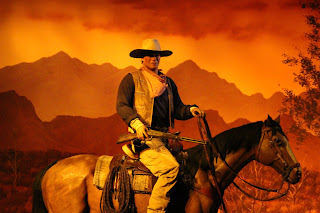
an audio animatronic of John Wayne as his character Ethan Edwards telling guests to turn back. I at the time forgot the name of the movie for how young I was, but remembered that it was a western starring John Wayne. So in hopes for me to eventually stumble across the movie, I bought and rented a few John Wayne westerns for a short period of time, until I found the name of the film through my research of the ride back in Middle School. I then rented the film a while later at my local library and found myself enjoying the visuals, John Wayne's performance, and its sense of adventure, but I remember having a strong disconnect as I was watching it. I don't know if it was because the film failed to suck me in; or if it was the time and place I was watching it, since I was in the living room in front of my family where there was a lot of chit-chat going as the DVD kept skipping. I haven't seen the film since then, so after purchasing a copy, being in a quiet environment, and having more of the motivation to watch and review it, is the film really as grand of a western classic as its been hyped up to be and that I was too distracted to get invested into it, or is it an overrated film that was more influential for its style instead of substance? ON WITH THE REVIEW!
Taking place in Texas in 1868, John Wayne stars as former Confederate soldier and Indian fighter Ethan Edwards, who after a few years returns to visit his brother Aaron (Walter Coy), Aaron's wife Martha (Dorothy Jordan), and his family including little Debbie (Lana Wood) and her adoptive brother Martin (Jeffery Martin). After hearing about a native tribe stealing cattle from their neighbor Rev. Captain Samuel Johnson Clayton (Ward Bond); Ethan, Clayton, and Martin, go out to recover them only to find out that the theft was a trick to separate the men from their families. When Ethan and Martin return to Aaron's ranch they find the place burned to the ground with everybody murdered except for Debbie and her older sister Lucy who have been abducted. Filled with a lust for vengeance, Ethan and Martin embark on a 5 year search for the tribe led by the ruthless chief Scar (Henry Brandon) to find the girls.

When "The Searchers" was first released the film wasn't considered to be one of the greatest western films of all time, or even so much as one of the best films made that year. It was pretty much seen by critics as another western collaboration between John Wayne, and film director John Ford with a simplistic adventure premise that had everything you'd expect to see in a film of this type. When I first saw the movie, I had a similar reaction because it did feel like any ordinary western made at the time, but I didn't think it was bad. I was still eager to know if they'll succeed with finding the girls or not, and how far or close they are from the tribe. And after seeing it again, though I knew how the film was going to end, I still found myself hooked in their quest as they go from one visually distinctive location after another where they would either find a clue, get ambushed by Natives, or revealing something new about themselves, while being given top notch performances from the cast, especially John Wayne who obviously stands-out the most from the others because he's freaking John Wayne, and gives all the classic mannerisms when you think of "The Duke".
As we're given an exciting adventure, we're treated to some of the best visuals that John Ford has ever captured on film during his film career! Right after the film's opening credits, we see a black title card telling us where and when the film is set, which at first it seems like Ford is going to make darkness and the title fade away and cut to the desert landscape where Ethan's family lives. But instead, after the title card disappears, we're still in total darkness, until we see a woman opening a door right in front of us exposing this wide-open beautiful landscape where she and her family live as John Wayne rides into the picture to greet the people he's left behind for the last couple of years. As soon as I saw that opening shot (completely forgetting all about it from my first viewing) I felt teleported into the film's world for how surprising and glorious it looked, when the opening credits were simply played in front of a backdrop brick wall providing no clue of what's in store for the viewer. It's almost as if Ford was intending to make the film's opening credits feel like an overture in front of a distinctive closed curtain to a play, and using the shot of the door opening to reveal this western world as a symbol for the curtain rising without you even seeing it coming. And when the film ends, it ends with a door closing taking you back in total darkness, away from this western world and back into reality as the music finishes, just like how a curtain closes at the end of a show.

I remember the film looking visually pleasing to the eye, but just like the opening and closing shot, I didn't remember the film looking this gorgeous! How Ford captures places such as the dusty painted desert landscape in Monument Valley, the foggy swamps, and the snow covered hills of Canada creates a world of both beauty and hardship, because as you're admiring the land for its colors and wide open spaces you're also getting a grip of this harsh reality for how vulnerable the people living in it are for how large and brutal it seems. But as if capturing these locations doesn't make the film look as beautiful as gazing at the auras, Ford enhances the beauty of the film for his since of art-direction from his use of costumes, lightning, and even the make-up painted on Scar's face that just make the colors in this film really pop-out at you. However, when a scene calls for something dark and grim, Ford tones down the colors just enough for them to stand-out, but lets the darkness, shadows, the ominous sunset, and fires engulfing the area be the certain of the visuals when creating mood. And given that the film has such breath-taking visuals to suck you into its atmosphere, the film's score composed by Max Steiner (who has composed epic film classics such as "Casablanca", "Gone With the Wind", and "The Treasure of the Sierra Madre") does the same amount of justice as he did for his other works. It sounds as big and grand as Ford's eye for vision that creates tons of thrill and excitement, while also sounding heartfelt and ominous in the places where it needs to be without making the scenes it’s playing for sound pretentious and corny for how perfectly it fits the scene! The film even has a song called "What Makes a Man to Wander" sung by "The Sons of the Pioneers" that's played in the opening credits and closing scene of the film that does a nice job of setting up its western tone and having you exit the film as you're listening to such wonderful harmony from a famous singing group who have golden classic country voices.

The film seems to deliver everything you would want to see in a western starring John Wayne, are there any problems that the film has. Well a few. The most common criticism that the film suffers from the view of a modern audience member is the portrayal of Native Americans, for having the stereotypical characteristics that is considered to be inaccurate and stereotypical, as the leader of the tribe is played by a white actor in brown make-up, which is easy to understand why people would be turned off by the film for how offensive it is. The most cringe worthy moment involving the Native Americans that I found to be quite uncomforting is the scene when Martin kicks a native woman that he accidentally married down a hill after she tries to cuddle with him, that was supposed to be funny, but just comes across as cruelly mean-spirited for its abusive, racist, and sexist nature towards women who aren't white and speak English.
While the film has a captivating adventure story, there's a subplot that brings the excitement and mystery to a halt, and that's the romance between Martin and a farm girl who he shares a past with named Laurie (Vera Miles). It's not that these scenes are bad. Hunter and Miles do have good chemistry, there are many parts to this subplot that connect to the overall story to still keep it moving forward, and it does still manage to entertain. The problem is a lot of the elements presented during this subplot feels gimmicky and forced. Considering the fact that John Wayne doesn't have a love interest during the course of this film and is accompanied by a handsome young actor, since many westerns at the time feel the need to throw in some kind of love story, the romance between Martin and Laurie feels shoehorned just to give audiences what they want, even though it's not really the focus of the film or anything really that important to the overall plot. And to keep these scenes from being boring considering that the two have little of an arc to work off-of except for the fact that Hunter is too busy searching for his sisters rather than staying behind with her, the film throws in a few 30 second to 1 minute long song and dance scenes; and some awkward comedy whether it being a character as over the top as Laurie's Father (John Qualen), or a fight scene that's played for nearly the same amount of laughs as the ending to "The Quiet Man" just without it being as goofy and long. These aren't necessarily the only parts of the film that are guilty of these forced choices that don't fully work, for instance there's a crazy Indian fighter played by Hank Worden that Ethan and Martin constantly encounter through their journey who's trying so desperately hard to be both weird and funny, that he comes across as weirder as opposed to funny. It's just that this overall love triangle that Martin gets into are the parts of the film that greatly show most of its weaknesses for how hard it’s trying to entertain to keep the audiences' attention.
The film overall is indeed a well-made western that has the typical tropes (both good and bad) that westerns at the time were known for. So why is nearly every critic, film historian, and fan of westerns claiming it to be such a masterpiece? Why does this John Wayne film get the most attention when compared to his other western classics?
Well when most of us hear John Wayne's name we think of him as the charismatic American hero who we love to always root for! So how about having a film where he's still the main character but isn't as charming and likable as he usually is. When I described the film's plot, I did say that he was searching for his kidnapped nieces but what I didn't mention was that he's only searching for them just to kill them! I certainly bet that you wouldn't suspect John Wayne in a film to do something as sadistic as that! Why does he wish to commit such a senseless act, because he hates natives with an extreme prejudice, and as far as he is concerned once the girls have been converted to their culture, he no longer sees them as his white nieces believing that they have been tarnished and that there's nothing he can do but eliminate them! So, Wayne is not only thirsty for the blood of innocents related to him, but he's a flat-out racist too, who doesn't keep his racism to himself, he's completely opened about it. It's not often that you see "The Duke" play a character this vicious and cold, if anything it's highly rare. He despises Native Americans so much, that he knows a great deal about their culture and war strategies and uses it against them rather than understanding why they are what they are. Best example is when he shoots out the eyes of a dead warrior explaining that without his eyes he can't enter the spirit-land, as his only way of killing a native from beyond the grave! Ethan's racism isn't the only draw-back to make his character different than the others he's played because he is bitter and condescending to almost everyone he meets whether its Martin, or Rev. Captain Samuel Johnson Clayton, who without remorse is willing to put their lives on the line for his own protection and personal gain; and has a long history of committing robberies and other crimes which all makes him the darkest and ominous character that John Wayne's ever played who's frankly more frightful than the film's main villain!

So, if Ethan is so ruthless, racist, and sick, why were so many audiences attached to this character? Is it just simply because John Wayne's playing a different kind of cowboy, well it is shocking and its highly fascinating to see your lead in a western at the time be so empty and full of hate, but it's not the heart of why many people find him so interesting. It's merely the complexity of his character that makes him so fascinating. Despite coming off as rude and twisted, there are times where he'll have his softer moments (like how he interacts with his brother's family and wife Martha), and a sensitive side exposing his vulnerability that he tries hard to keep away from other people. Ethan hates Natives, but despite Martin being part Cherokee it's revealed earlier in the film that Ethan rescued him after his family was slaughtered by the Comanche. And though his hatred towards Natives is awful and wicked, you understand why he's become the man he is for what they did to his brother's family and (subtly hinted) his wife where these acts of violence that they've heartlessly carried out make him behave just as vicious as they are. Making matters worse for Ethan, he is also a loner. He has the knowledge that Natives have, but refuses to aid or be a part of them because of his hatred. He's surrounded by people who need him for his brains and talents, but Ethan doesn't feel like he belongs with them because he's not like them. And the only people that Ethan ever showed deep love and affection for are all dead! The film's focus is more on the psyche of Ethan and the people around him, than it is on the search, if anything that element is only there to tie everything together while giving audiences what they would want to see in a western. We know about Ethan's bigotry and see him do a few heroic deeds from time to time, but the film never fully explains how far his racial intolerance goes and how much he cares for the people around him, it's more up to the viewer to decide, making this one of the early westerns that challenges its audiences by making them think rather than just entertaining them where everything is all black and white.
Ethan maybe the film's main character, however the film never tries to make his racism and acts of vengeance to be justifiable because when you see Ethan scalp a warrior or cut them off from their food supply, these moments are grimmer and more shocking than they are played out as an act of heroism for how down-beat it is. Even during a scene when we see the Calvary invade a tribe’s camp, as obvious that the scene is more triumphant on the side of the white man taking down the natives, the scene is given a dark edge to prevent it from being too one-sided because in one shot we see of a frightened Comanche woman protecting her child from gun-fire that's obviously not supposed to mean that the violence happening in the scene should be rooted for. There's also another massacre towards a Native tribe before the attack where we focus on the after-math instead of the battle, and how this scene plays out as we gaze at the dead bodies of numerous warriors and innocents from the tribe is gloomy and disturbing as opposed to being glanced over and coming off more as a dead end to the characters journey, and that the soldiers were right for killing nearly every Comanche in sight.
The most obvious attack on the film's themes against racism is Ethan's sidekick Martin. Being part Cherokee, he gets the most abuse from Ethan more than any other character in the film because of his blood-line, and for opposing against Ethan's objective for killing his nieces than retrieving them, since Martin still sees them as family whether being converted to being a Comanche or not, and will do whatever he can to block Ethan at every turn. If you really analyze the arcs to Ethan and Martin, you'll discover in a shocking twist, that Martin is the film's true hero. Martin develops from being a whiny innocent sidekick, to a much tougher cowboy who's determined to do the right thing as the film progresses from his experiences during this adventure and Ethan's attitude towards him. Ethan though having his moments of heroism never really changes from this whole journey, and still remains as the racist loner from when we first met him. In fact when you get to the film's climax the focus isn't on the characters fighting Scar's tribe, it's really the conflict between Ethan and Martin on whether or not Ethan's going to still do what he's been planning on doing for all these 5 long years. The strained relationship that these two have together is honestly one of the most interesting and compelling relationships that I've seen in a western film for how they are both the complete opposite from each other where the film doesn’t really address how much they actually do care for one another.
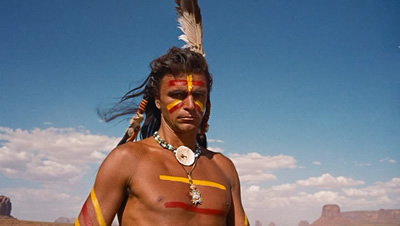
A character who is just as fascinating as Ethan is, is the tribe leader Scar. When watching the film for the first time many casual viewers who watch Scar will automatically view him as the average one-dimensional main villain, which is easy to grasp why. He's killed and abducted Ethan's family, has an intimidating presence whenever he's on-screen, and has slaughtered countless white soldiers and settlers as he kidnaps women and takes the scalps from some of his dead victims as trophies. He's as barbaric as a villain of this type can get. However, what separates Scar from being the typical savage archetype that Hollywood was doing with most native antagonist at the time is that he has a reason for his savage acts. Ever since his two sons have been massacred by the white man, Scar fueled with hate and vengeance wanted to take revenge against the white race for what they've done to his sons, and most likely as well as what they are currently doing to his people. Sound familiar? That’s because he's Ethan's native counterpart who are both alike in many ways but can't accept each other's differences from their blind hatred towards one another's race. Much like how I described how rare it was at the time to have our leading hero in a western (especially when being played by Wayne) be an anti-hero with flaws that are too numerous to mention, diving into the problems of the white settlers violently taking over the Native American’s land through the perspective of a Native American villain was not usually common either. Usually the only way you'd see a Native American portrayed in a positive light in a western is if they were partnered up with the cowboys, otherwise they'd be portrayed as cold hearted savages to make the white characters invading their land look heroic and righteous. To have a western make the Native Americans seem more human and relatable by showing a bit of their prospective of the racial tensions involving them though not the first film to tackle it is still quite ambitious and a-head of its time. Is it a dignified portrayal of Native Americans, no they still fall under that stereotypical archetype of how America viewed them at the time which definitely reveals the film's age. But Ford's heart in delivering this message is still in the right place and having him hiring actual Native Americans to be casted in the film definitely brings a sense of realism to their suffering, if not an accurate depiction to their culture.

Above everything that makes this film such a brilliant and different kind of western is how much meaning and depth is given to it. It's one of those films where the more you watch it, the more you'll notice little details that connect to the film's themes and characters. Whether it being a small piece of dialogue that's easy to overlook, an interaction between the characters that you haven't noticed before, or visuals that either add a whole new layer to character or situation or have much more meaning to them than they appeared at first glance. It's a western with so many layers of emotion, character, themes, and meaning that it's not all spelled out to you or preaching its message, it's letting the visuals and interaction between the characters do all the expressing as what a visual medium should do! Even during the mediocre parts of the movie, there's still some form of intelligence behind it to prevent them from being a complete waste of time.
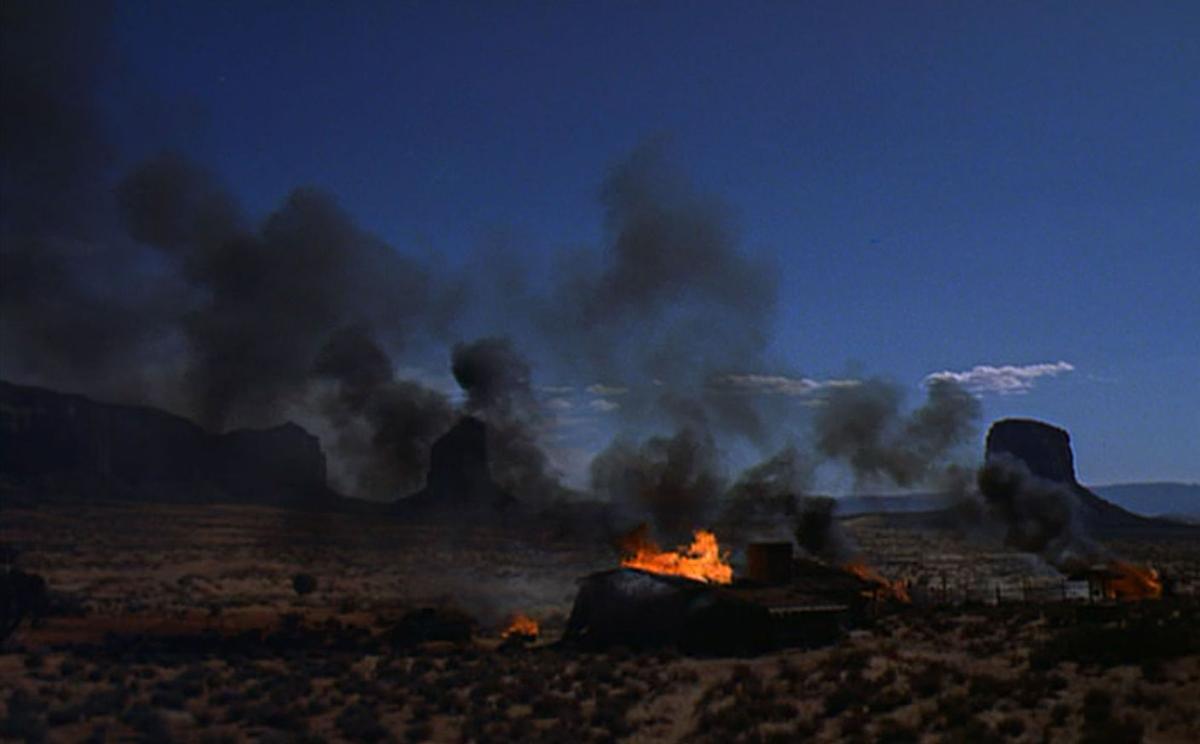
Because of the film's grand visuals, complex characters, clever use of story-telling, and unsuspected twists to the western genre it went on to influence numerous successful writers and filmmakers, where they would either pay homage or take elements that made the film such a ground-breaker and perfect upon it. Spielberg would use the concept of people who are opposite from each other working together in finding someone in a cruel environment in his World War II epic "Saving Private Ryan", and would have a scene of a guy in shock clenching his hands in the sand after seeing a dead body in his blockbuster thriller "JAWS". Martin Scorsese and Paul Schrader would have a modern parallel to the characters of Ethan and Scar in "Taxi Driver" through the characters of Travis Bickle and Sport. Director David Lean studied the visuals in the film countless times in order to create what many consider to be his most visually breath-taking epic "Lawrence of Arabia". George Lucas would use the idea and imagery of a farm burning down with innocents being killed as the start to Luke Skywalker finally setting foot out of Tatooine to embark on an adventure through the galaxy in "Star Wars". The image of the door closing at the end of the film, gave Francis Ford Coppola the idea to end "The Godfather" on a powerfully sad note. And of course Sergio Leone would take some of the film's darkness and anti-hero qualities from Ethan, and exploit them to a whole new level in his "Dollars Trilogy" with Clint Eastwood. The film has also influenced one of the greatest Rock N Roll musicians of all time Buddy Holly to write one of his essential songs after John Wayne's famous catchphrase "That'll be the Day".
OVERALL THOUGHTS
There's so much more that I wish to write and analyze about the film in terms of scenes, techniques, themes, and subtle details in the story after doing some research and watching some of the scenes from the film a few times to study them in preparation for this review. I've pretty much only talked about half of the things that make this film so rich and clever, and as tempting as it is for me to provide more reasons and insight on the film's genius, I believed that what I've covered should be more than enough to give you an idea of how magnificent this film is! No film is perfect, and this film does have its issues regarding its dated depiction of Native Americans, and shoehorning in certain tropes in westerns that don't feel needed for this film. But none of that overshadows of what a smart, ambitious, and influential milestone of a cinema that the film is rightfully known to be! It manages to excite, surprise, and keep you captivated in its lovely and dangerous western environment and story-line, while also taking risks and challenging its audience, pleasing both the casual film-goer who just wants to be entertained, and the scholar who wants more than what's expected in a film of its kind.






